去骨瓣减压术祥解
- 格式:ppt
- 大小:960.50 KB
- 文档页数:16



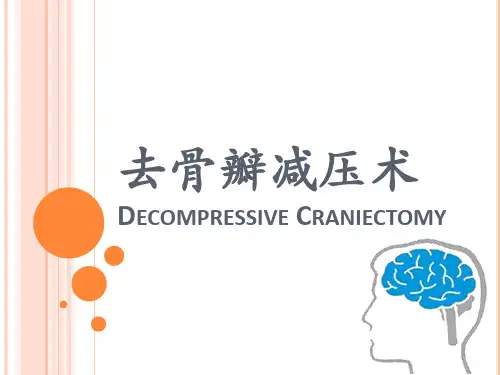

标准去骨瓣减压术指南
标准去骨瓣减压术是一种用于治疗颅脑损伤、脑出血等疾病的手术方法。
以下是标准去骨瓣减压术的详细指南:
一、手术适应症
标准去骨瓣减压术适用于各种原因引起的难以控制的颅内高压,如颅脑损伤、脑出血等。
在急性颅内压升高的情况下,该手术可以快速降低颅内压,减轻对脑组织的压迫,从而保护脑功能。
二、手术步骤
1. 切口:在额部上方,沿颧弓上缘切开皮肤,向两侧弧形拐弯至耳廓上后方。
2. 颅骨切除:在骨膜下分离颅骨,切除额部和顶部的一块大小约
12cm×15cm的颅骨。
3. 硬脑膜切开:将硬脑膜呈放射状切开,并向下翻转。
4. 颅内减压:通过扩大硬脑膜切口和剪除部分硬脑膜,进一步降低颅内压。
5. 缝合:将硬脑膜和头皮分别缝合。
三、注意事项
1. 手术前应完善相关检查,明确病因,评估手术风险。
2. 手术后应密切监测颅内压和生命体征,及时处理并发症。
3. 手术后应定期复查,评估手术效果。
4. 在恢复过程中,应注意营养和康复训练,促进患者尽快康复。
总之,标准去骨瓣减压术是一种有效的治疗颅内高压的方法,但需要在医生的指导下进行。
如果您需要接受该手术,请务必遵循医生的建议和指导。

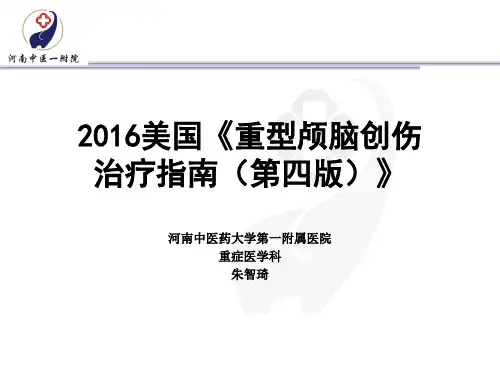
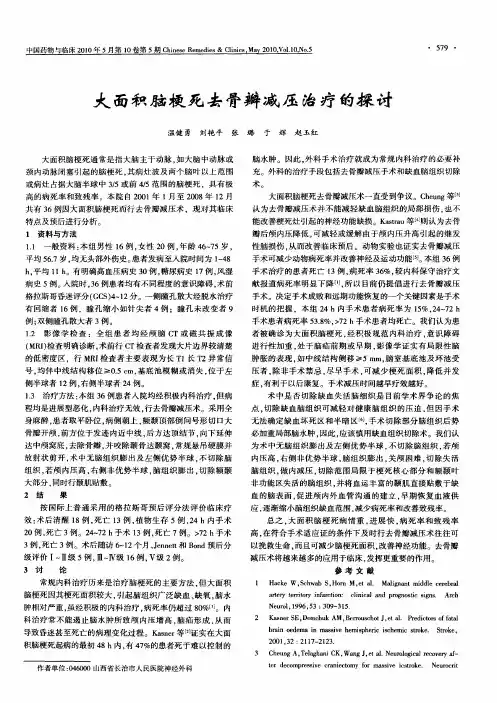
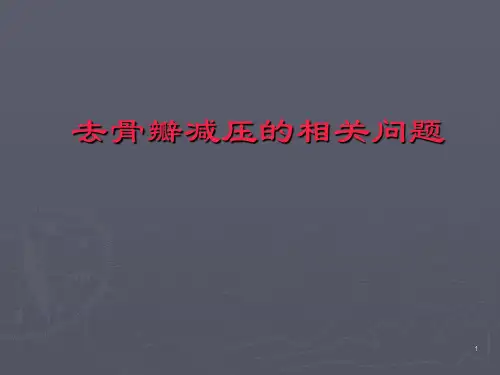
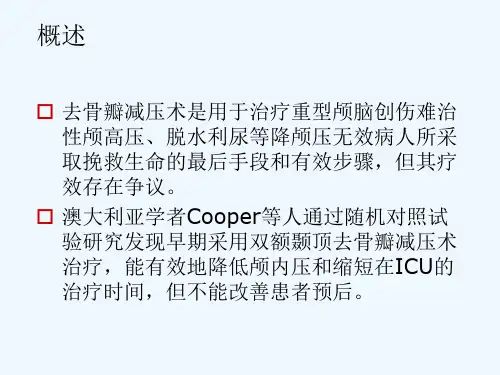
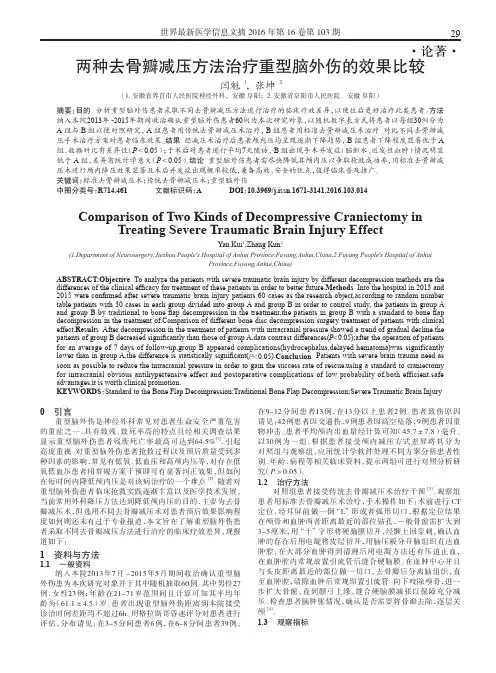
世界最新医学信息文摘 2016年第16卷第103期 29·论著·两种去骨瓣减压方法治疗重型脑外伤的效果比较闫魁1,张坤2(1.安徽省界首市人民医院神经外科,安徽 阜阳;2.安徽省阜阳市人民医院,安徽 阜阳)摘要:目的分析重型脑外伤患者采取不同去骨瓣减压方法进行治疗的临床疗效差异,以便往后更好治疗此类患者。
方法纳入本院2013年-2015年期间收治确认重型脑外伤患者60例为本次研究对象,以随机数字表方式将患者以每组30例分为A组与B组以便对照研究,A组患者用传统去骨瓣减压术治疗,B组患者用标准去骨瓣减压术治疗。
对比不同去骨瓣减压手术治疗方案对患者临床效果。
结果经减压术治疗后患者颅内压均呈现逐渐下降趋势,B组患者下降程度显著优于A 组,数据对比有差异性(P<0.05);于术后对患者进行平均7天随访,B组出现手术并发症(脑积水、迟发性血肿)情况明显低于A组,差异有统计学意义(P<0.05)。
结论重型脑外伤患者需尽快降低其颅内压以争取抢救成功率,用标准去骨瓣减压术进行颅内降压效果显著且术后并发症出现概率较低,兼备高效、安全的优点,值得临床普及推广。
关键词:标准去骨瓣减压术;传统去骨瓣减压术;重型脑外伤中图分类号:R714.461 文献标识码:A DOI:10.3969/j.issn.1671-3141.2016.103.014Comparison of Two Kinds of Decompressive Craniectomy in Treating Severe Traumatic Brain Injury EffectYan Kui1,Zhang Kun2(1.Department of Neurosurgery;Jieshou People's Hospital of Anhui Province,Fuyang,Anhui,China,2.Fuyang People's Hospital of AnhuiProvince,Fuyang,Anhui,China)ABSTRACT:Objective To analyze the patients with severe traumatic brain injury by different decompression methods are the differences of the clinical efficacy for treatment of these patients in order to better future.Methods Into the hospital in 2013 and 2015 were confirmed after severe traumatic brain injury patients 60 cases as the research object,according to random number table patients with 30 cases in each group divided into group A and group B in order to control study, the patients in group A and group B by traditional to bone flap decompression in the treatment,the patients in group B with a standard to bone flap decompression in the treatment parison of different bone disc decompression surgery treatment of patients with clinical effect.Results After decompression in the treatment of patients with intracranial pressure showed a trend of gradual decline,the patients of group B decreased significantly than those of group A,data contrast differences(P<0.05);after the operation of patientsfor an average of 7 days of follow-up,group B appeared complications(hydrocephalus,delayed hematoma)was significantly lower than in group A,the difference is statistically significant(P<0.05).Conclusion Patients with severe brain trauma need as soon as possible to reduce the intracranial pressure in order to gain the success rate of rescue,using a standard to craniectomyfor intracranial obvious antihypertensive effect and postoperative complications of low probability of,both efficient,safe advantages,it is worth clinical promotion.KEYWORDS:Standard to the Bone Flap Decompression;Traditional Bone Flap Decompression;Severe Traumatic Brain Injury0 引言重型脑外伤是神经外科常见对患者生命安全严重危害的重症之一,具有致残、致死率高的特点且经相关调查结果显示重型脑外伤患者残废死亡率最高可达到64.5%[1],引起高度重视。
有占位效应的重型颅脑损伤术后再次手术去骨瓣减压41例分析赵鹤翔;徐丁;杨朝华【摘要】Objective To analyze the experience of re-operation using decompressive craniectomy (DC) to treat the patients with severe traumatic brain injury (sTBI) for mass lesions. Methods From Jan.2008 to Oct.2014, the sTBI patients who underwent craniotomy for mass lesion evacuation in West China Hospital were retrospectively reviewed.The initial demographic and radiographic features were analyzed to identify risk factors of secondary DC requirement. Results There were 41 patients who underwent re-operation using DC, including 34 cases of regional edema and progressive traumatic hematoma, 6 cases of focal neonatal hematoma and 1 case of remote site hematoma. Conclusion The incidence of re-operation using DC after craniotomy was 14.4%.For most mass lesions patients without malignant brain swelling, craniotomy is an acceptable surgical method in primary intervention.For patients with subdural hematoma associated contusion, early hypotension and higher initial intracranial pressure (>35mmHg), DC may be required.%目的总结重型颅脑损伤患者因占位性损伤术后再次手术去骨瓣减压的治疗经验.方法回顾性调查2008年1月~2014年10月在四川大学华西医院住院的重型颅脑损伤患者病历,筛查第一次手术清除脑挫裂伤或硬膜下血肿等占位性损伤术后保留骨瓣但再次手术去骨瓣减压的患者,分析再次手术去骨瓣减压原因.结果 41例术后再次手术去骨瓣减压,其中术后局部脑水肿和进展性出血34例,术区新发血肿6例,远隔部位血肿1例.结论有占位效应的重型颅脑损伤患者术后有14.4%的患者再次手术去骨瓣减压,对大多数没有术中脑膨出的患者保留骨瓣是安全的,但对于硬膜下血肿伴脑挫裂伤、伤后早期低血压和初始颅内压>35mmHg的患者可能需要去骨瓣减压.【期刊名称】《创伤外科杂志》【年(卷),期】2017(019)005【总页数】3页(P379-381)【关键词】颅脑损伤;去骨瓣减压;再次手术;颅内压【作者】赵鹤翔;徐丁;杨朝华【作者单位】610041 成都,四川大学华西医院神经外科;610041 成都,四川大学华西医院神经外科;610041 成都,四川大学华西医院神经外科【正文语种】中文【中图分类】R651.1去骨瓣减压术在神经外科应用多年,特别是在重型颅脑损伤的救治中有重要作用。